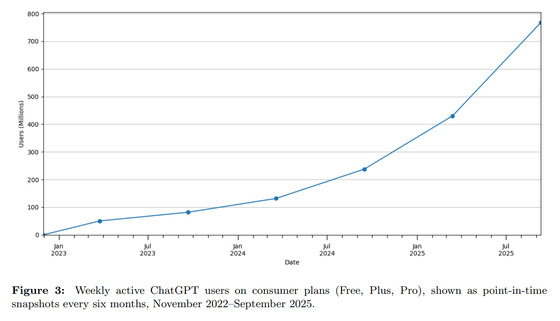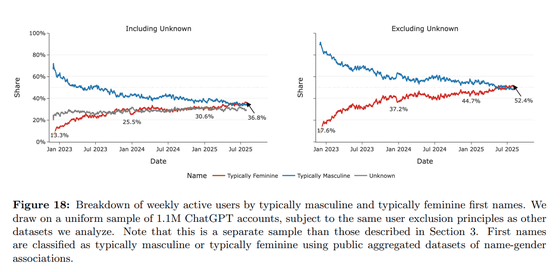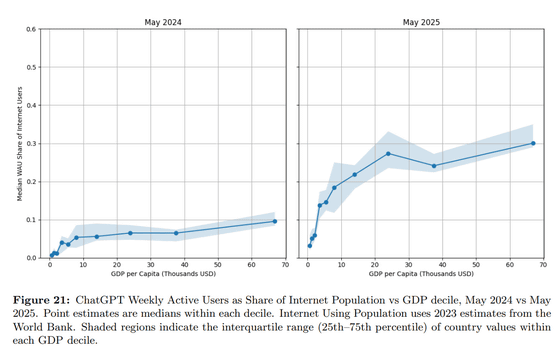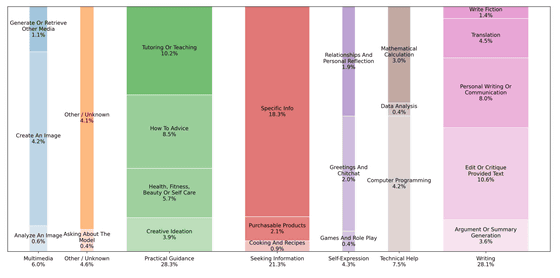OpenAI releases first detailed survey results on ChatGPT usage, revealing 73% are used outside of work

OpenAI, Harvard economist David Deming, and others have jointly released the largest study to date on ChatGPT usage trends, analyzing data from 1.5 million conversations and revealing how ChatGPT is creating economic value in both professional productivity and personal benefits.
How People Use ChatGPT | NBER
How people are using ChatGPT | OpenAI
https://openai.com/index/how-people-are-using-chatgpt/
OpenAI: Women Make Up 'More Than Half' of ChatGPT Users | PCMag
https://www.pcmag.com/news/openai-women-make-up-more-than-half-of-chatgpt-users
Our research shows that ChatGPT's user base is expanding globally and becoming more diverse. As shown in the line graph below, by the end of July 2025, the number of weekly active users had exceeded 700 million, accounting for approximately 10% of the global adult population.

In particular, in the early days of the launch, users with male names were the majority (about 80%), but the gender gap narrowed dramatically, and by June 2025, users with female names (red) exceeded those with male names (blue).

There were gender differences in usage topics, with female users tending to use 'writing' and 'practical guidance' more often, while male users tended to use 'technical help' and 'multimedia.' By age, young people aged 18 to 25 accounted for approximately 46% of all messages, while geographically, adoption is accelerating, with growth rates in low- and middle-income countries reaching more than four times that of high-income countries.
The graph below compares a country's economic wealth (GDP per capita) and its ChatGPT adoption rate in May 2024 (left) and May 2025 (right). The horizontal axis represents GDP per capita (in thousands of dollars), with countries moving to the right indicating increasingly economically prosperous countries. The vertical axis represents the median percentage of internet users in each country who use ChatGPT at least once a week. Comparing right to left, we can see that adoption has accelerated particularly in low- and middle-income countries with GDP per capita between $10,000 and $40,000.

In terms of usage purposes, work-related use accounts for approximately 30%, while personal use accounts for approximately 70%. The proportion of personal use in particular has grown rapidly, increasing significantly from 53% in June 2024 to 73% in June 2025. Looking at specific conversation topics, the three categories of 'practical guidance,' 'information gathering,' and 'writing' account for approximately 80% of the total.
'Writing' was the most common work-related use, accounting for 40% of all work use. Approximately two-thirds of this 'writing' involved requests to edit, summarize, or translate user-provided text, rather than creating new text from scratch. Additionally, 10.2% of all messages were related to 'tutoring/education,' indicating that education is an important use case. Meanwhile, other uses, such as computer programming (4.2%) and consultation/reflection on personal relationships (1.9%), accounted for relatively small proportions.

The research team introduced three new indicators to categorize user intent: 'Asking,' 'Doing,' and 'Expressing.' The results showed that 49% of interactions were 'Asking,' which seeks information or advice for decision-making, 40% were 'Doing,' which requests specific deliverables such as writing an email or coding, and 11% were 'Expressing,' which are conversations without a specific purpose. When limited to work use, the proportion of 'Doing' interactions rose to approximately 56%. Interestingly, in indicators measuring user satisfaction, interactions related to 'Asking' tended to be rated higher than 'Doing.'
Furthermore, we found that users with higher education and professional occupations tended to use the app more for work purposes, and that at work they tended to use the 'Asking' function, which seeks advice, rather than the 'Doing' function, which directly executes tasks. Analysis of job content using the U.S. Department of Labor's Occupational Information Network (O*NET) revealed that, regardless of occupation, use of the app was concentrated in two functions: 'obtaining, documenting, and interpreting information' and 'decision-making, problem-solving, and creative thinking.'
From these results, the research team concluded that ChatGPT creates economic value not only as a tool for automating tasks, but also as an 'advisor' that supports human decision-making and improves productivity, especially in knowledge-intensive occupations. Furthermore, the rapid expansion of ChatGPT's use outside of work suggests a significant contribution to social welfare that cannot be measured solely by productivity improvements.
Related Posts:







